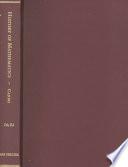Quotes from book
A History of Mathematics

Originally issued in 1893, this popular Fifth Edition (1991) covers the period from antiquity to the close of World War I, with major emphasis on advanced mathematics and, in particular, the advanced mathematics of the nineteenth and early twentieth centuries. In one concise volume, this unique book presents an interesting and reliable account of mathematics history for those who cannot devote themselves to an intensive study. The book is a must for personal and departmental libraries alike. Cajori has mastered the art of incorporating an enormous amount of specific detail into a smooth-flowing narrative. The Index - for example - contains not just the 300 to 400 names one would expect to find, but over 1,600. And, for example, one will not only find John Pell, but will learn who he was and some specifics of what he did (and that the Pell equation was named erroneously after him).In addition, one will come across Anna J. Pell and learn of her work on biorthogonal systems; one will find not only H. Lebesgue but the not unimportant (even if not major) V.A. Lebesgue. Of the Bernoullis one will find not three or four but all eight. One will find R. Sturm as well as C. Sturm; M. Ricci as well as G. Ricci; V. Riccati as well as J.F. Riccati; Wolfgang Bolyai as well as J. Bolyai; the mathematician Martin Ohm as well as the physicist G.S. Ohm; M. Riesz as well as F. Riesz; H.G. Grassmann as well as H. Grassmann; H.P. Babbage who continued the work of his father C. Babbage; R. Fuchs as well as the more famous L. Fuchs; A. Quetelet as well as L.A.J. Quetelet; P.M. Hahn and Hans Hahn; E. Blaschke and W. Blaschke; J. Picard as well as the more famous C.E. Picard; B. Pascal (of course) and also Ernesto Pascal and Etienne Pascal; and, the historically important V.J. Bouniakovski and W.A. Steklov, seldom mentioned at the time outside the Soviet literature.
